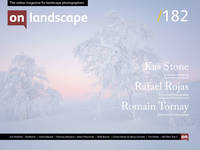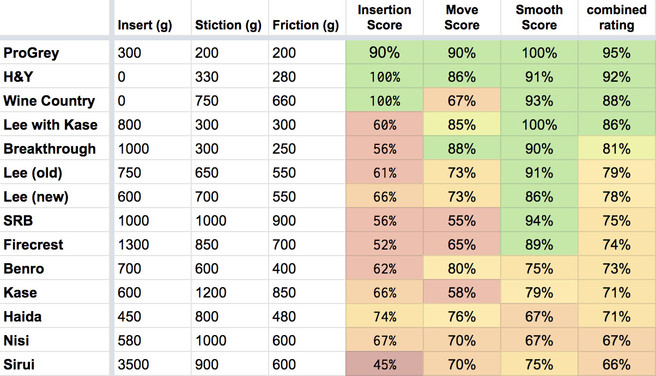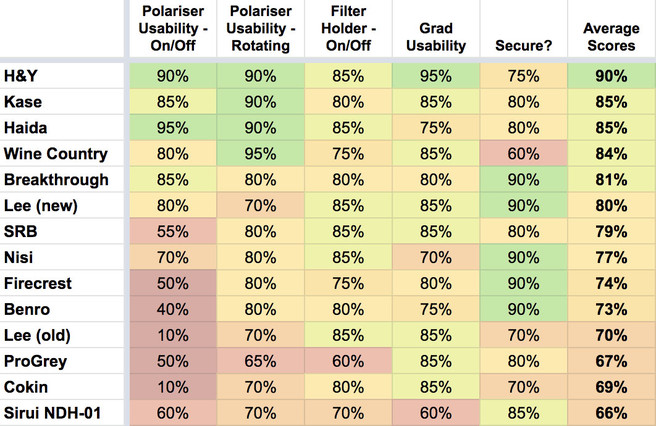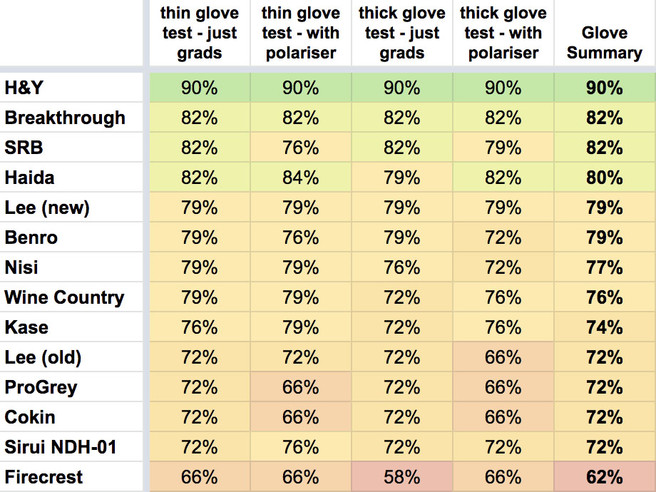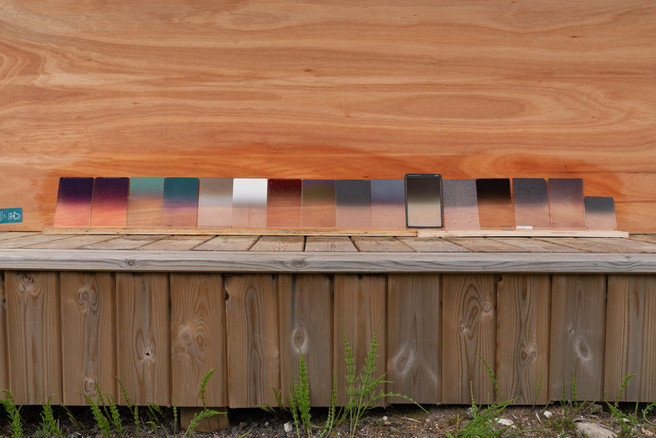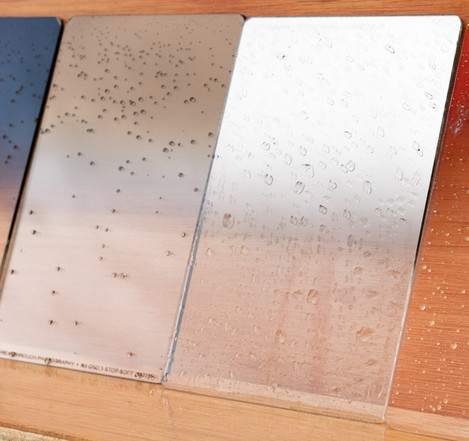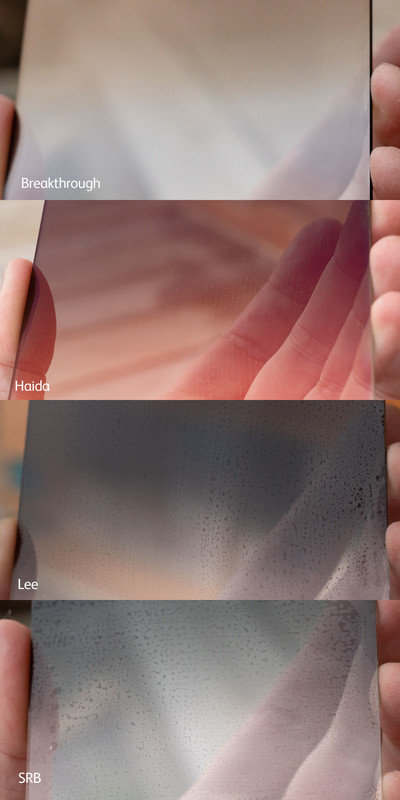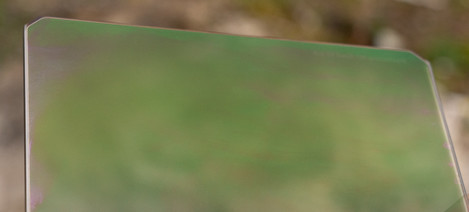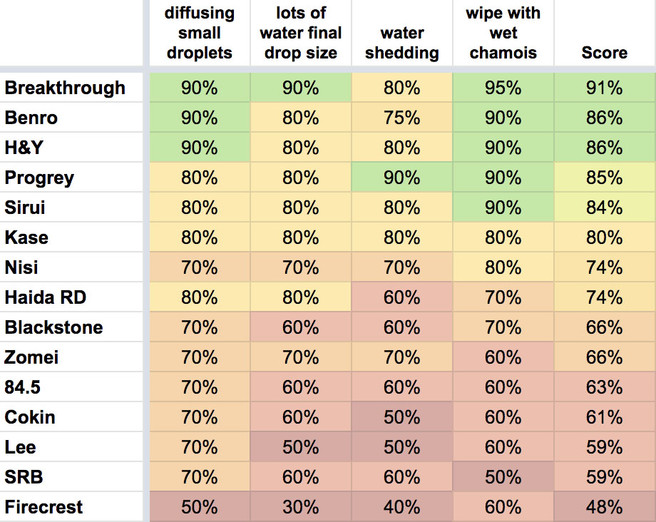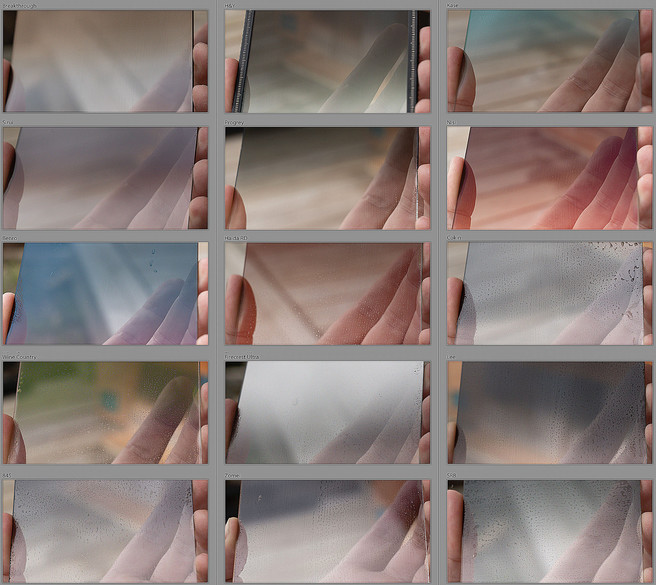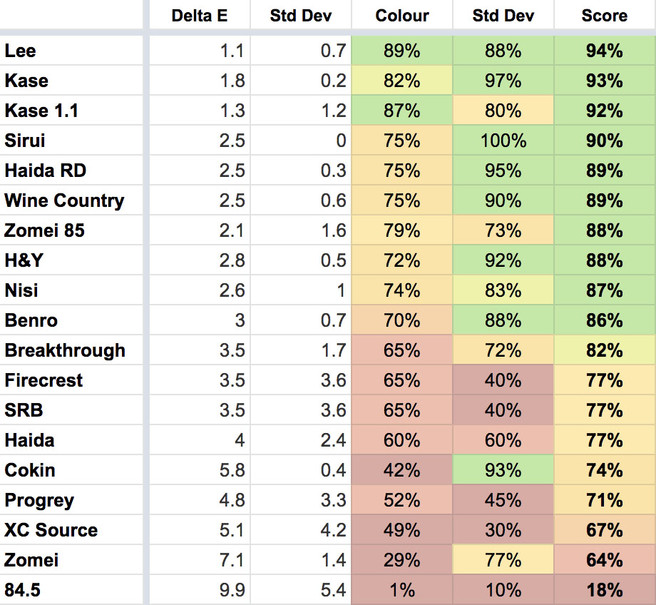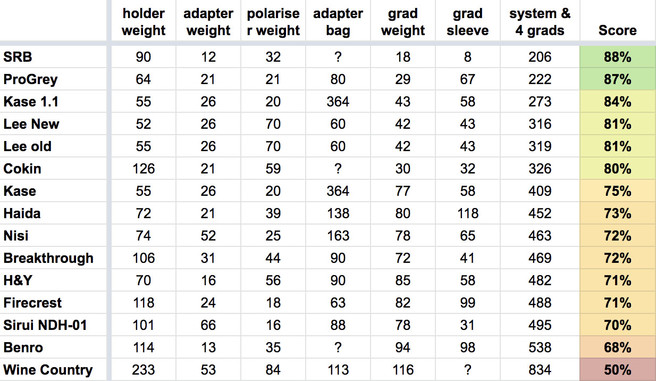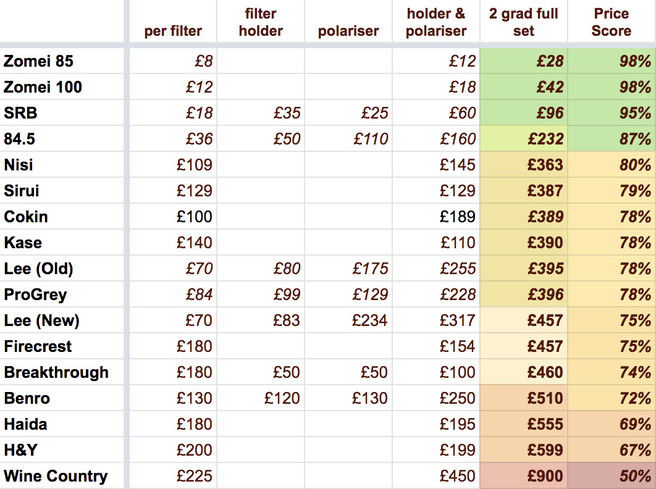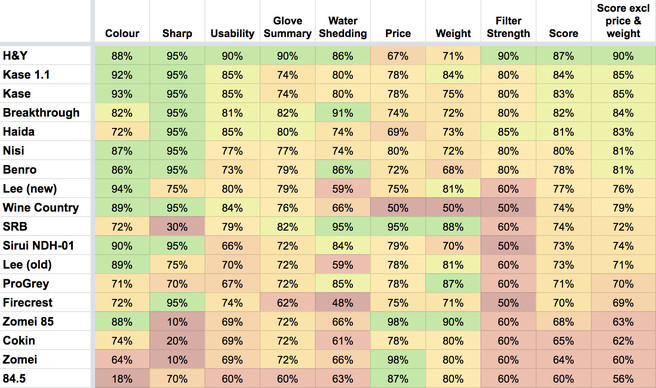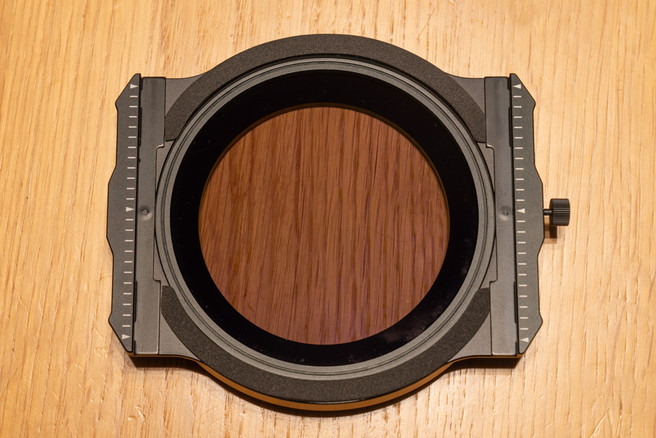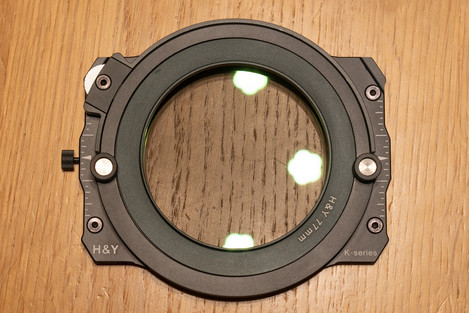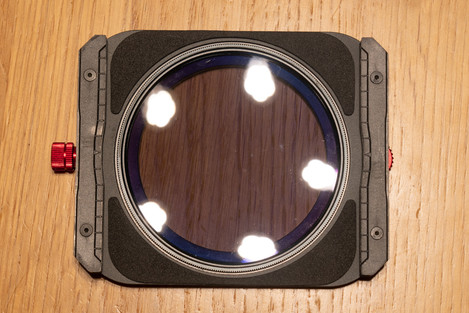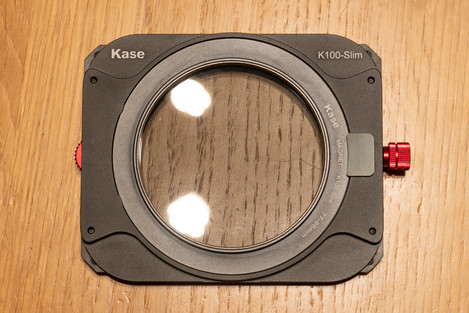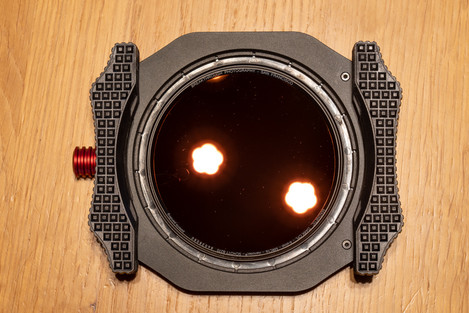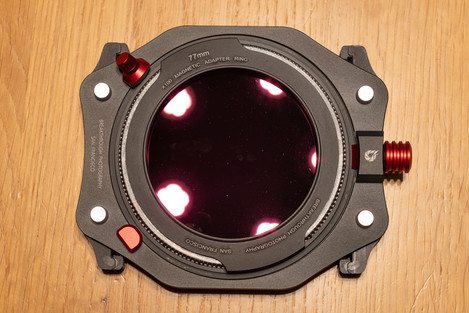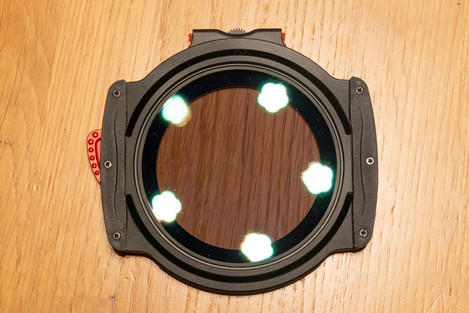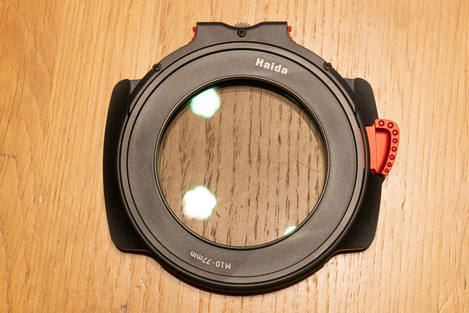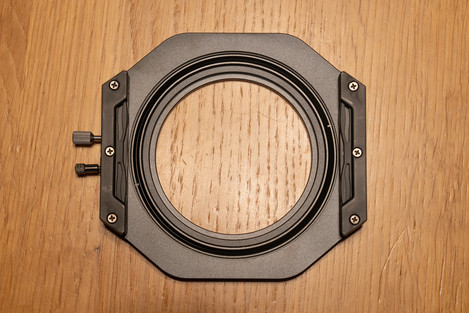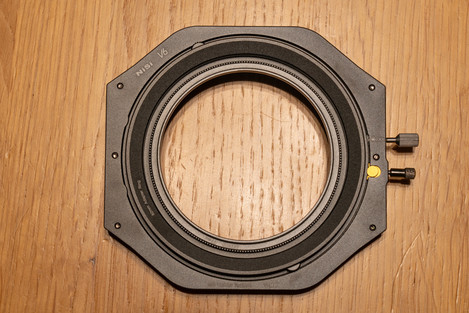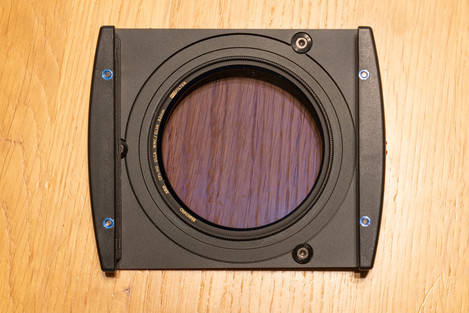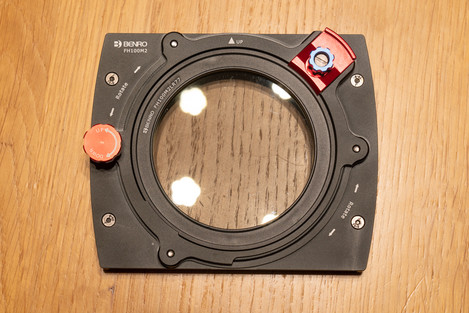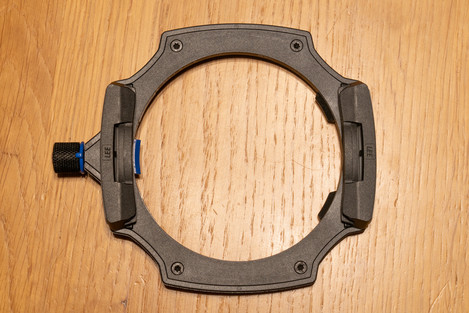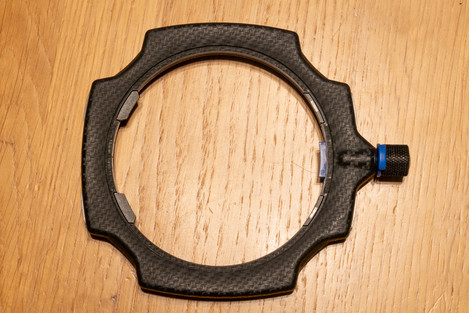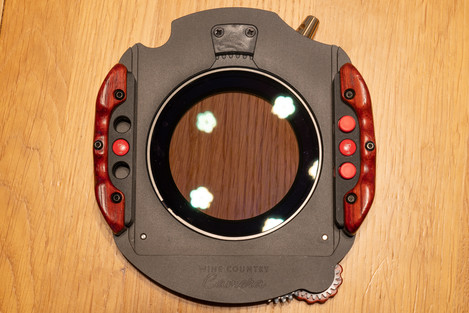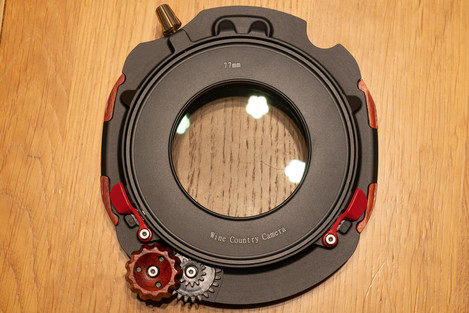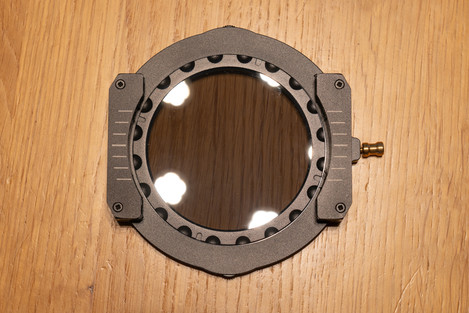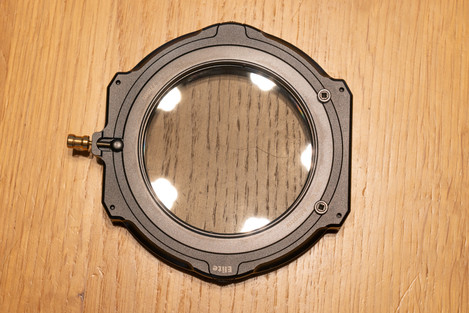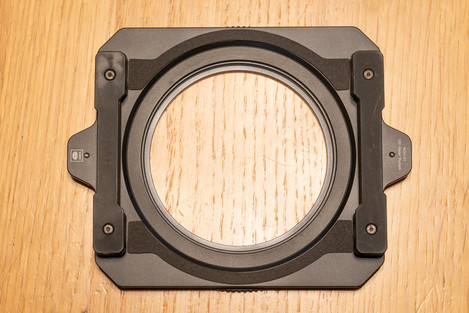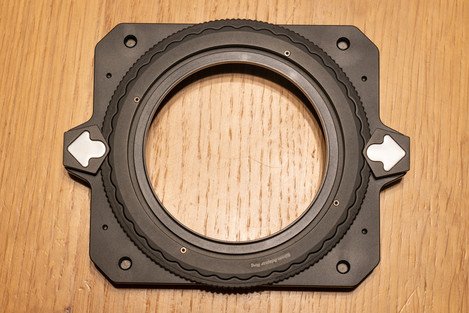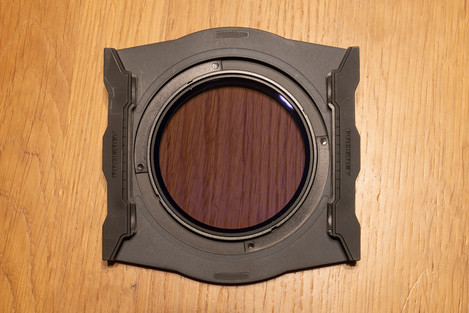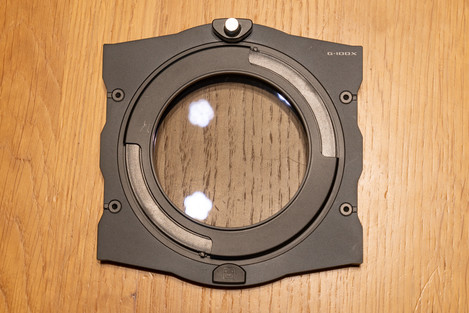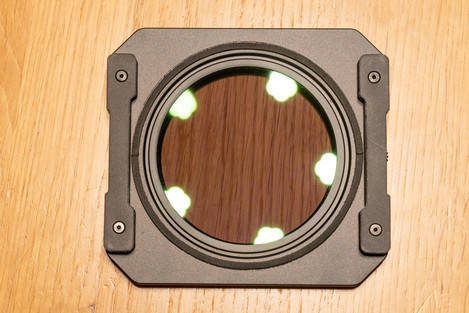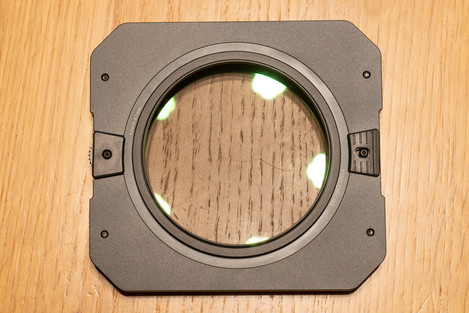Usability, Water Shedding and Final Scores

Tim Parkin
Amateur Photographer who plays with big cameras and film when in between digital photographs.
Our Graduated filter system tests are nearly at an end (or at least at a point where I’m happy to commit to some conclusions as someone has just reminded me about vignetting tests and a final video in the field).
The latest couple of tests that I’ve undertaken have been about usability, both in terms of getting the filters on and off, rotating polarisers, inserting graduated filters, etc and finally seeing how easy they are to keep clear of water and dirt. Plus I’ve weighed the filter components and looked up the prices.
NB: Since making these tests we have been contacted by Cokin who would like to add the following "At the time the test and review was conducted, Cokin’s UK distributor was only able to supply the CR39 resin X-Pro filters. Whilst these performed well, they are not up to the standard of certain glass filters. However, Cokin do now have a full range of high-performance, glass ‘NUANCES EXTREME’ filters available and Tim will be reviewing these soon, when Cokin’s new filter holder system is launched". Hopefully we'll follow up this review with some extra changes that have happened across a range of filters.
Inserting and Moving Grads
My first analysis looks at how easy the filters are to insert, move up and down and whether they are ‘sticky’ or not. I did this by measuring the amount of force needed to make each movement and then assigning some ‘weightings’ to each to give a final score.
Here’s a screenshot of the graph of results, click here to see the full spreadsheet.
I wouldn’t worry too much about differences of a point or two here. I would have four main groupings
Very Good
H&Y, ProGrey, Wine Country and Lee with Kase
Good
Lee (old and new) and Breakthrough
Average
SRB, Firecrest, Benro, Kase, Haida, Nisi and Sirui
I’ll cover some of the actual differences when we get to the usability scores and the description of each later in the article.
Usability
Personally, as long as any colour casts are within a reasonable range, it’s the usability of a filter system that makes the biggest difference (cost aside for a moment) and so I’ve spent the last few months trying out the different systems in a range of conditions. I’ve also tried each system using gloves of various thicknesses as well to simulate those cold winter mornings when the last thing you want is to fight with your equipment on top of freezing half to death.
Here's a screenshot of the usability results which you can access directly by clicking on the image.
As you can see the columns show different aspects of usability which should be self-explanatory. The 'security' column shows the risk of knocking the adapter off or not attaching it correctly. Also, the chance of dropping or knocking off graduated filters or polarisers.
And here's a screenshot of the glove testing which you can access directly by clicking on the image.
The thin gloves were a pair of fleece thinsulate gloves (such as these, the thicker pair were Rab Guides (see here).
Water Shedding
I wanted to check just how good the water-resistant/easy clean coatings were and so I made a few tests where I used a spray bottle to slowly soak the filters and then gave them wipes with a wet chamois and then finally tried to clean them properly using a dry cloth. Here’s a photo of all of the filters in their wet state.
The results surprised me as I was expecting just a small difference and the filters to be grouped into resin, uncoated and coated but in fact, there were lots of finer-grained differences. The very best filters kept the drop size quite small when the filter was getting wet and shed the water easily. Here's a comparison of the way the drops formed between a good filter and a bad filter - in this case, Breakthrough (left) vs Firecrest (right).
They also were fantastic when wiped as the only remaining bits of water were very tiny and could hardly be noticed through the viewfinder and these dried off quickly because of their size. The worst ones just smeared big blobs of water everywhere and remained wet even after wiping. Here’s a comparison sample of the best to worst filters (in this case Breakthrough, Haida, Lee and SRB).
We also noticed a difference in the way that the filters cleaned. Some filters (such as the Wine Country/Blackstone shown below) smeared a lot. This couldn’t be seen through the viewfinder but was annoying never-the-less). Some cleaned OK after a few wipes (Resin filters) and most of the glass filters cleaned quite quickly (the best corresponding to the best in the water wipe test). I factored this into the water shedding results but it was only a small factor and didn’t change order of results.
Here's the final table showing the water shedding scores which you can access directly by clicking on the image
Here’s a gallery of all of the water shedding results :-
and here is a gallery so you can see each in close up.
Overall Scores
Before we get to the final overall results, I wanted to include three tables showing the colour accuracy scores from the previous issues and also the price and weight tables. Click on the table to access the full google spreadsheet.
Colour
Weight
Price
I have created a table of results showing various aspects of each system and grading them as a percentage. These ‘scores’ will inevitably have a little bit of subjectivity and arbitrariness about them but along with the short video on each system in the next issue and my written description you should get an idea when they rate as they do. I’ve created a weighted total in the last column, one taking into account price and weight and the other excluding them.
I’m reviewing these in the order of the total which takes into account price and weight. If you exclude price and weight the order doesn’t change too much but the Wine Country and Sirui both go up one place.
H&Y
The H&Y filters were a late addition to the tests and were a recommendation by Giovanni Coronna and I’m very grateful he did so as they’re probably my favourite filters (despite the price, more on that later).
The main things to know about the H&Y setup are that the filters are in caddys, and very secure ones; they mount magnetically; the polariser/ND’s use a drop in system with a cog for adjustment (which I love); and the holder uses a slightly add way of attaching which seems insecure but is actually ok once you’re used to it.
Magnetic filters
This is the obvious talking point and looks a bit like black magic when you first play with them. Given the price of the grads, I was a bit nervous at first. However, knowing that the grads are made from Corning Gorilla Glass (like the latest phone screens) and that they have the caddy to protect the edges (where breaks usually start) I didn’t feel too bad. However, what looks like a screw lock to prevent the filters being knocked off is just a tension lock to prevent accidental adjustment up and down. I did a quick check on how much force you need to actually knock them off made me think it would be good to have an accessory slot at the front to prevent and to give a little mental reassurance if you’re hanging over cliffs or mountains, etc. I’ve used this system more than most though and never had a problem (including hanging over cliff edges in Skye). UPDATE: H&Y confirmed they are releasing a replacement front design that clamps the filters in place which will be released before Autumn hopefully.
The big advantage of magnetic filters is the ease of use of the system. It’s so easy to quickly place a grad on, especially with gloves, and stacking two filters was very simple with the cumulative magnetic force actually making the second filter more secure.
Drop in Polarisers and ND filters
Both H&Y and Haida use a drop in filter system and in my mind it’s the ideal solution to annoyance of screwing in and unscrewing filters. The second best alternative is the magnetic polariser system used by Kase and Breakthrough. H&Y’s drop in filters have a very prominent adjustment wheel with a good action and which uses a detent system to hold the filter in place (which means it won’t drop out even shaken around upside down). H&Y have a few options for drop in filters including a polariser, 6 stop ND & polariser combo and a 10 stop ND with rumors of a drop in variable ND later this year.
Corning Gorilla Glass v3
If you’re spending a lot of money on filters, taking care of them becomes a major factor. Having filters made of toughened glass makes a big difference and having been sent a sample by Kase and thrown it around on gravel and concrete I’ve been very impressed at their strength. H&Y filters go a step further and use Corning’s Third Generation Gorilla Glass. This is substantially stronger than toughened soda lime glass (B270) which you can see here. At £200 a filter, I haven’t tried throwing them around but with the caddy system protecting the edges, I think you’d be hard pushed to break them from normal drops.
Unusual Mounting System
Unlike most filter holders, the H&Y has a novel way of mounting onto their adapters. It’s best to watch the video to see how this works but the following photo might make things clear but it’s like the Cokin way of attaching but with a couple of locking screws either side.
I was at first a bit sceptical of this but in the field, it works well, even with gloves on, and is quite secure. It takes a little adapting too if you’re used to the usual side clipping system though but it’s probably just as secure and as easy to use once you do adapt.
Conclusion
Overall the H&Y is an excellent system, good quality graduated filters with magnetic mounting, simple usability through drop in polarisers and NDs and all reasonably lightweight. Definitely my pick of the crop.
Kase
My choice for second place went to Kase because of a great balance of very few negatives, the cost is excellent, they’re the lightest system (for a holder and four grads), the water repelling was great, they’re easy to use and they’re the best classic filter system in my opinion. The weight can be reduced to sub-resin levels if you wanted to get their 1.1mm system as well!
So let’s take a look at some of the details of why we liked Kase
Graduated Filters
The filters are B270 toughened glass and from my own rough tests are very tough indeed. Kase supplied a sample of the glass which I’ve been throwing around on concrete and gravel to no ill effect. The colour accuracy of the filters is also very good indeed with the 1.1mm filters testing the very best using a spectrophotometer. I also like that they include a ‘medium’ filter (as do Lee, Haida, Nisi and 84.5).
Holder
The holder is the lightest on the market if you include the polariser and second lightest, just below the new Lee holder, if you don’t. It’s also the simplest to use and the only two negatives I can raise about it are that it uses a screw in clamp (I’d like to see a simpler spring latch with a screw in lock) and the polariser is hard to remove with gloves on.
Polariser
The lightest polariser going at 20g, because it excludes the rotating system (this is a permanent feature of the adapter). It’s a magnetic system which makes it very easy to attach (although harder to remove because of clearance).
Conclusion
A really good value, classic polariser system. Currently the best ‘heir’ to the Lee throne.
The Rest
Below H&Y and Kase which I think would be first and second by most ways of judging, in our weighted scoring table are a bunch of systems quite close together and the relative order changes a bit if you change the weighting. I would say that Breakthrough, Haida, Nisi, Lee, Benro and Wine Country would all make most people very happy. They each have their advantages and disadvantages including price and weight. It depends on what you value and how you use your filter systems. I’ve worked out my own weightings and hence results and will order these comments based on these.
Breakthrough
Despite the slightly hyperbolic marketing (no they weren’t the first at everything and no they don’t have the most colour accurate polarisers, ND or grad filters), the Breakthrough was generally pretty good across the board. I like their glass filters which felt great and shed water and dirt exceptionally well. I also give bonus marks for polariser usability and simplicity.
Magnetic Polariser
Although a lot heavier and more bulky than the Kase polariser, the Breakthrough one is a lot easier to attach and remove. It’s adjustment is via a ribbed ring sitting on the adapter itself. I have to make a personal objection to the way that some filter systems have a bulky adapter (with some others like the Nisi forcing the use of step up rings). I much prefer a simple adapter ring with no strings attached (although I forgive Kase the simplicity of their adapter which includes a rotating front as it is still compact).
The polariser is really easy to locate and it snaps in with a strong magnet. However, it is quite stiff and unless the adapter is screwed into the lens well, I have had it unscrew on me as I try to adjust the polariser (familiarity may make this easier though).
The polariser can be removed without taking the system apart as long as you’re not wearing thick gloves (unlike the Kase, for instance, which needs a prominent nail to hook under)
Classic Slots
One of the joys of the Breakthrough system is the use of classic slots for filters, just like Lee have used for years. This isn’t a bad thing as it makes inserting and adjusting filters very easy with little faffing and sticking. Sometimes simple is good!
Conclusion
So the Breakthrough scored pretty well through being very usable, especially with gloves on, having easily manageable filters and not being too bad in the other departments. A solid showing.
Haida
This is another drop in filter system which gets bonus points for polariser usability but it’s not quite as easy to use as the H&Y one. However, the rest of the Haida system is also good. It’s easier to use with gloves than the Kase system although inserting grads needs a little bit of practise as they don’t line up quite as easily. We tested both the Haida RD and normal Haida. The colour of the RD was definitely better with the obvious advantages of robustness and seemingly a bit better coating.
Drop in Polariser and ND
The Haida drop in polariser uses a pinch lock system which seems more secure than the H&Y (although I couldn’t get either to bunch passively once inserted fully). This can also be used for ND filters and is excellent at stopping light leaks. The drop in filters are also lightweight.
Graduated Filters
In colour terms, the Haida were more than acceptable for general use but they weren’t as accurate as the other glass filters and had more variability (most had a small cool cast). They also weren’t great at shedding rain and wiping off water. The holder does make inserting grads slightly more difficult as the ‘tension’ on the sides of the slots is positioned to it resists just as you start inserting the filter and the slots aren’t very deep which means you have to get the filter exactly aligned to insert cleanly - not a major issue as I imagine you would get used to it.
Conclusion
A good system that ticks a lot of the boxes. The grads could be more colour neutral but they’re good enough that most won’t notice (and way better than most resin filters). The holder design with the drop in polariser/nd system is the way to go in my opinion but there are a couple of usability issues with this (more difficult in gloves) and the aforementioned grad insertion issue that means it didn’t get a better score.
Nisi
The Nisi system is a very good value setup, especially now they produce their cheaper tempered glass filters, and has pretty good usability. There’s certainly nothing to dislike about the system but there are a few minor niggles. We tested both the 'optical glass' Nisi filters and also the toughened 'Explorer' range. There was no discernible difference in colour or sharpness.
Combined Adapter and Polariser Mount
A few filter systems tested use the combined adapter and polariser system. Kase, Firecrest, ProGrey, Breakthrough all have some version of a polariser mount and a way to rotate it. My issue with this system is partly the increased bulk on the end of each lens (if you have an adapter per lens) or having to screw a single adapter on each time you use it.
Kase and Firecrest make a very slimline version of this where you’d be pushed to tell at first that it uses this system. Breakthrough and ProGrey use larger versions with a knurled ring around the edges to rotate the filter. Nisi uses a more complex system where the adapter has the cog included and has to use step-up rings to adapt your lens to the adapter.
Personally, I prefer to have a simple adapter permanently mounted to each of my lenses.
Screw Mount Polarisers
Nisi also use a screw mount polariser which makes usability an issue in some cases. They do mitigate some of the issues by having a very short throw thread (only takes a half a turn to screw down and it locates the start of the thread a lot quicker than other systems) but it’s never going to be easy with gloves on. It’s nowhere near as bad as the Benro polariser which I can’t actually remove at the moment (despite stripping my nails off in the process). Magnetic attachment or drop in polarisers is definitely the future.
Toughened Glass Filters
If you’re spending double the price of the Lee filters to get a glass system and using them outside in some difficult conditions, the last thing you want is to have them break even through small falls. Nisi has made a point out of saying their filters are made from optical grade glass and try to explain in their literature that they think their toughened glass filters are inferior optically. The claim doesn’t really stand up to scrutiny, however.
The supporting literature says “"Is image quality different? Yes! You may not see a great deal of difference". In fact, you almost certainly won't see any difference because of the glass material itself as B270 (toughened glass) is used for lenses as well as the ‘optical glass’ H-K9L. The difference is a very slight change in light transmission and a tiny difference in refractive index. For a complex lens design made out of H-K9L might have a bit more transmission than a similar lens made using B270 but for the 2mm of filter in front of the rest of the filter system there will be no visually discernable difference. As for optical quality, as they are both used in lens systems, the optical quality will be governed by whether the filters are optically flat or not. In my own tests (in a previous article) I couldn’t see any difference between any of the glass filters tested, even though I was photographing through the filter held at 45 degrees to a 400mm lens at nearly 50mp.
Personally, I think the cheaper, toughened glass filters that Nisi have just introduced under their “Explorer” brand are a no brainer purchase.
Conclusion
A very competent filter system with few major disadvantages (most of which are to do with the adapter and polariser).
Benro
Benro threw in a real curveball with their graduated filter system. Not only did they include a caddy system but it has cogs on the side and has a geared system to move them up and down. Overkill? Read on!
Geared Graduated Filters
In the quest for more selling points, Benro has introduced what has to be the most bling. A geared system for adjusting the height of graduated filters. Each caddy has linear gears on the side and the main holder has a big red wheel that you can push or pull to align with the slot you wish to adjust and, once engaged, you can sit behind your camera and tweak to your heart’s content.
In reality, I found a couple of issues with this. The first is that the way the caddy inserts into the holder means it’s very easy to ‘cross load’ them. The second is that it’s really solving a non-existent problem. There hasn’t been a situation where I couldn’t just move the filters up and down with my fingers. I suppose I might be able to contrive a situation where I had three filters and the middle one was lower so I could only access the bottom where it stuck out. But I’d be happy to work around this.
Conclusion
Personally, I think the geared graduated filters are a bit of over-engineering. Others may find the feature useful so I’ll leave that open. The rest of the Benro system is OK - the graduated filters are good but not as colour neutral as some. The polariser attachment lets the system down and is very difficult to remove. Overall it’s an OK system that I’m sure many people will be happy with.
Lee
Lee have just redesigned their filter holder and it’s definitely an improvement over the old holder. The ability to lock the filter holder so it can’t get knocked and also lock the rotation if desired is a big win (you’ll know what I mean if you’ve ever had to look for the brass spring and knob, usually dropped in long grass). The holder itself now looks like a sports car accessory dressed in faux carbon fibre and electric blue flashes. However, it is actually injection moulded plastic which still has the benefit of being lighter than a metal equivalent and makes the new Lee holder the lightest on the market at 52 grams.
New Latching Knob
Excuse the title of this section but I wasn't sure what else to call it. Essentially the new knob has a second blue ring on it that allows you to lock the filter on in one position and in the other to lock the filter on AND stop rotation, In practise, they seemed very similar and both did the locking job but made it hard to rotate the filter.
New Slots
The new slots are slightly different and make it easier to insert grads but they are a little ‘stickier’ than the old system (not by much though).
It’s worth mentioning that this ‘stickiness’ was noticed as an annoying aspect of a few of the holders tested (by stickiness, I mean the difference between the force to get the filter starting to move vs the force to keep it moving. If the starting force is high then the filter can ‘jump’ in position). For instance, the Haida holder was very sticky, as was the Nisi. On the other hand, ProGrey was amazingly smooth, as were the Lee and Breakthrough systems. When you’re making minor adjustments to grad positions, this stickiness can be quite annoying.
Polariser Mounting
Lee’s old method of mounting polarisers was a bit of a pain. It involved undoing the slots and then adding a metal ring to which you could screw in the overside polariser. Most people I know had two adapters, one with and one without the polariser, just to make things easier. The new system mounts the polariser onto a plastic adapter which has ‘clips’ either side which then push onto sockets on the filter slots. The polariser mounts easily enough and it has a nice cogged outer ring for adjustments but mine is exceptionally stiff to remove. I imagine it could get easier over time but I’ve yet to be able to remove it without first removing the adapter from the camera.
Graduated Filters
The graduated filters by Lee turned out to be the most accurate of all tested. This was very pleasing to see. However, I also tested some of my older filters (over 10 years old) and the results weren’t quite as good (to say the least). I won’t include those results here but I wouldn’t be buying them based on my tests.
Then again, I’ve used the old set for lots of photographs I’ve been very happy with which just goes to show that you don’t need perfect to be very happy with the results. Considering the price difference from the Lee filters to other manufacturers glass filters, you could easily replace Lee at least once and still be cheaper. There is a definite shift in colour over the years with Lee’s resin filters though.
The big issue with Lee’s filters is really the problems around dealing with static and also water shedding. Keeping them clean and clear was substantially harder than the better glass filters. Living with cats as I do means that the Lee filters probably had an extra stop of density reduction just through hair accumulation (OK, not quite that bad but you get the idea)
Conclusion
Both Lee’s old and new filter systems do the job very well for just graduated filters and the old system was really only let down by the polariser mounting. The new system solves some of that with a few teething problems. Not the most usable but you wouldn’t go too far wrong with it.
Wine Country Filters
The Wine Country system is one that I had very high hopes for. The developers have approached the problem with a “no holds barred” mentality and definitely not scrimped financially. Given all of this, it was a surprise to find the system had a few major flaws.
Firstly I’ll say that the system is very pretty indeed with stained wood side handles and polariser rotating wheel. The holder is made of a sturdy metal construction and the filter caddies out of a high quality glass fibre epoxy resin casts with a positively ostentatious brass coin controlling the locking action. Quite the accessory for Alpa lovers.
Adapter Attachment
The security of attachment of the filter adapter to the lens is particularly important. It’s doubly so when the system costs twice the price of other systems, is twice as heavy and doesn’t use toughened filters. As such you would expect an extra level of security. Unfortunately, the system used is a major let down. Essentially we have one screw retainer which doesn’t engage in a slot on the outer rim of the adapter and hence has to be fully tightened to prevent the filter holder falling off in any downward facing position.
Ideally, adapter systems should have a two-level attachment system. One ‘catch’ should allow quick attachment of the filter holder. A second level should allow the locking of the adapter down completely.
If the Wine Country system is used in a downward facing position and you wish to rotate the whole adapter to realign the grads, you must hold onto the whole adapter to prevent it falling off before releasing the screw and turning the filter holder.
Weight and Cost
The difference in weight between the Kase filter system and the Wine Country system is quite something. The Kase 1.1mm holder, polariser and four graduated filters come in at 273g whilst the equivalent Wine Country holder, polariser and grads is a hefty 834g, over three times as heavy. To go along with this increased weight, the Wine Country system is over twice the price of the Kase system.
Polariser Attachment
With such a critical start it’s nice to say something positive about the system. The way the polariser attaches and rotates is really well executed in the WC system. The positive action of the large wooden wheel rotates the polariser 90 degrees for a 180-degree rotation of the wheel and does so very smoothly. The two small clamps lock the polariser in place very well and should be a model for how the filter holder could lock onto the adapter.
Graduated Filter Slots
The caddies fit into slots on the front of the filter adapter up to the midway point and then beyond this, you have to depress a sprung button on the front of the left-hand slot. There are two buttons, one for each slot (the back slot being for ND filters and has a light trap). Once depressed the caddies move freely and letting go locks the caddy in place. Wine Country had a few issues with the tension of the buttons at first which allowed the filters to slip down but this has been fixed in a more recent design. One “Gotcha” which I fell for is holding the wrong filter as you press the button. This means the other filter just drops all the way. Fortunately, the system has a 'stop' to prevent the filter from falling out so just annoying rather than dangerous.
Conclusion
The Wine Country system is ultimately a disappointment. It plays on aesthetics more than functionality and for me, that is the wrong priority. However, it still performs well and, if you can forgive the usability issues, it will look sooo bling on the front of your camera!
SRB
SRB is a nice filter holder let down by poor grads and a screw in polariser. If they could make a glass filter and a magnetic polariser it would be a contender with some of the better filter systems as the usability was first rate.
Sirui
A much simpler polariser and filter holder system, the Sirui is competent but didn’t stand out enough to be an attractive choice despite having some of the more colour accurate graduated filters. The major let down was the action of mounting and unmounting the filter holder to the adapter and mounting and unmounting the polariser (a normal screw in).
ProGrey
A resin-based grad system with a simple slotted holder and adapter mounted polariser. The graduated filters had a cast that was noticeable in pictures. The system had a few usability issues such as a fiddly way of mounting (see final video in the next issue) and the screw in polariser wasn’t straightforward to use. However, the system was one of the lightest tested and the graduated filters were very smooth to insert and adjust.
Firecrest
One of the earlier filter sets we tested and which we were initially quite pleased with. However, in comparison with some of the other filters, it was let down by some usability issues (particularly with the screw in polariser and when using gloves). The filters were also the worst at shedding water and dust and were bad on smearing when cleaning. Overall they lost a small number of points across a range of issues and ended up quite low in the rankings. NB We tested the Ultra filters, not the older ones.
Other articles in this Graduated Filter Test series
Part 1: Filter Systems for Neutral Density, Graduated and Polarising Filters
Part 2: Graduated Filter Colour Accuracy Testing
Part 3: Graduated ND Filter Sharpness and Flare
Part 5: Graduated Filter Test: Scratch Resistance, Vignetting, Methodology and Usability Video

